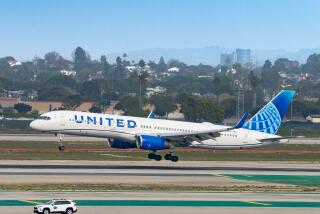Missing Bolt Blamed in Emergency Landing : Aviation: It prevented the jet’s nose and fuselage wheels from lowering at LAX. An identical part affecting the remaining wheels was working itself loose, investigators say.
- Share via
A United Airlines jumbo jet that had to make an emergency landing last week at Los Angeles International Airport was missing a tiny steel bolt from its nose and fuselage wheel system, preventing those wheels from lowering, a federal inspector said Tuesday.
Moreover, an identical bolt affecting the jet’s wing wheels--the final set of wheels upon which the aircraft landed--was working itself loose, said Jeff Rich, a National Transportation Safety Board investigator. If that bolt had fallen off, the nearly new Boeing 747-400, carrying 323 passengers and crew of 20, would have been forced into a belly landing.
“A belly landing is not something you want to see done because the potential for fire and explosion is great and the potential for injury and loss of life is there,” Rich said.
Rich, who supervised the NTSB investigation of the Aug. 27 emergency landing, said the pilot was in radio contact with United’s technical experts in San Francisco, attempting to work out the problem.
The plane, finishing a 13 1/2-hour flight from Sydney, Australia, had only 15 minutes of fuel left and a decision was made to make the emergency landing, Rich said. The jet skidded to a stop on eight wing wheels and two nose wheel doors, which had opened properly.
Two dozen passengers suffered minor injuries during the landing, primarily while using emergency evacuation chutes. Minor damage was reported to the aircraft.
A spokeswoman for Boeing Co. said that since January, 1989, 85 aircraft in the new 747-400 series have been delivered to 19 domestic and foreign carriers. The jet that made the emergency landing was delivered to United in January, spokeswoman Elizabeth Reese said.
Reese said the NTSB notified Boeing of the missing bolt the day after the emergency landing, and Boeing immediately alerted the 19 carriers to make certain that bolts were tightened in their aircraft. To date, she said, Boeing has been told that 40 of the 85 jets have been examined and that there are “no reports of any missing bolts.”
Also, she said, Boeing workers “double-checked” jets being manufactured at its Seattle-area production facilities to make sure bolts were properly installed.
“It is a safe airplane,” she said. “Part of the process here is to investigate what happened and to make sure it doesn’t happen again.”
NTSB’s Rich said that it could not immediately be determined whether the bolt, three-eighths of an inch in diameter by 1 1/2-inches long, dropped off in flight or was improperly installed during production.
He said the jet had 2,952 flight hours and the bolt was not due to be inspected until the aircraft had flown 6,000 hours.
The bolt in question is located high in a left wheel well in the fuselage. It is part of a critical linkage that gives the pilot the ability to raise and lower the jet’s two nose and eight fuselage wheels.
A second bolt, identical in dimension and affecting the hydraulic system for the jet’s eight wing wheels, had come loose as well, Rich said.
Federal officials and passengers gave the plane’s crew high marks for an expert landing. After touching down on the runway in an unsuccessful effort to jar the wheels loose, the pilot landed the big jet, holding the nose aloft as long as possible before it dropped to the runway and screeched to a halt on its nose wheel doors.
Rich said the NTSB investigation is not completed.
More to Read
Inside the business of entertainment
The Wide Shot brings you news, analysis and insights on everything from streaming wars to production — and what it all means for the future.
You may occasionally receive promotional content from the Los Angeles Times.










